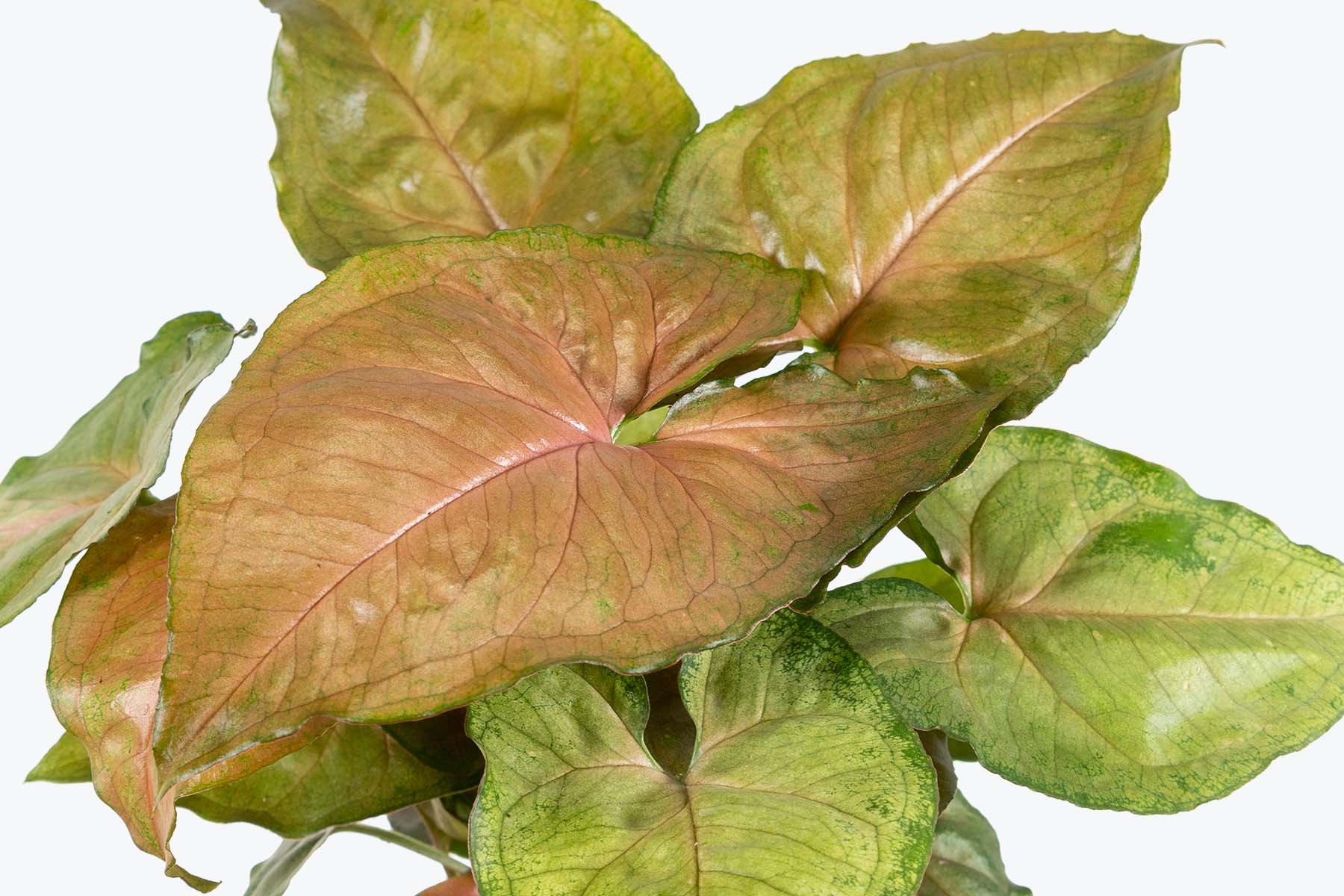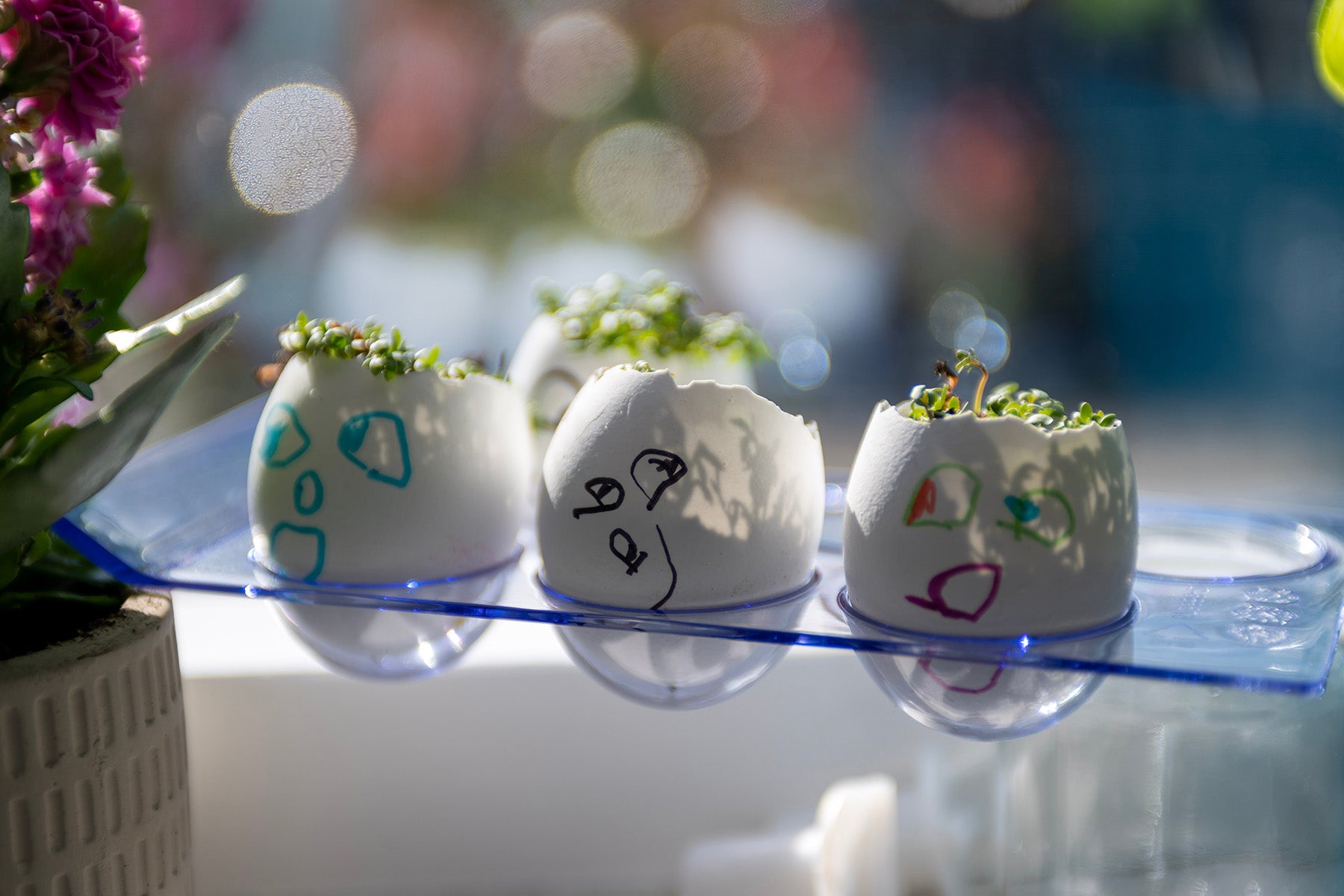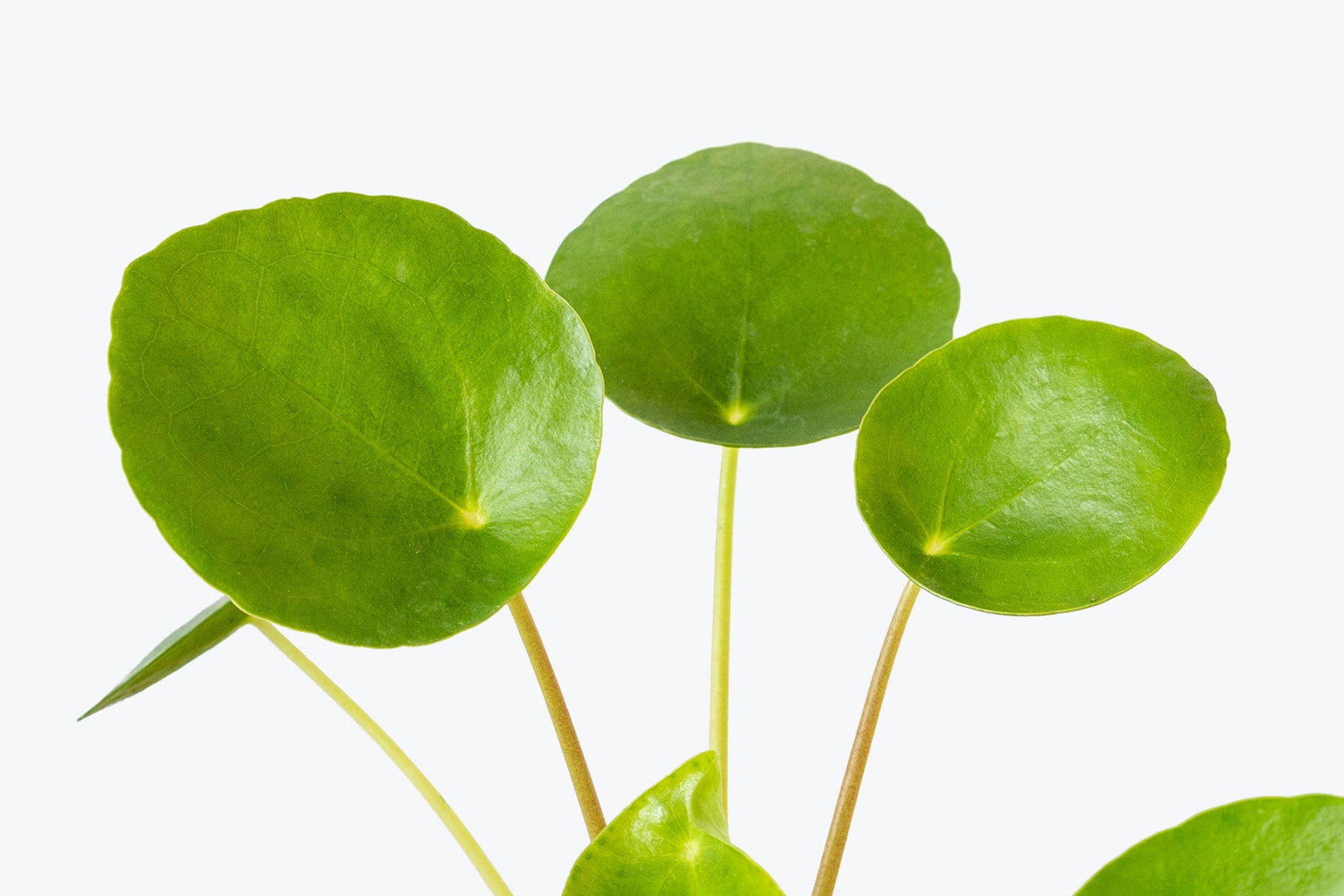
How to Take Care of Your Arrowhead Vine (Syngonium)
If you are looking for an easy-care houseplant that grows relatively quickly and produces unique foliage coming in a plethora of colours and patterns, look no further than the Syngonium genus! Native to the tropical rain forests of Central and South America, the Syngonium, aka Arrowhead Vine, Arrowhead Plant, Goosefoot, Butterfly Plant, or Nephthytis, belongs to the Araceae family, along with Alocasia, Dieffenbachia, and Philodendrons, just to name a few. Knowing this, it is clear that the Syngonium is an aroid, of which most are primarily grown for their foliage over their rather unimpressive flowers, or inflorescences, consisting of a spadix and spathe.
△ 4" Syngonium Mango Allusion
Syngonium are fantastic houseplants with spade or arrow-shaped leaves, sought after by those just starting out with plants as well as those who have owned plants for years. Why are they so popular? Well, their easy-going nature is the biggest draw since they can put up with plenty of conditions, from lower light (not no light) to bright light, and they grow quite rapidly, almost always unfurling new leaves during the growing season. Their low-maintenance nature makes them an extremely versatile plant, especially since they come in a wide range of colours and textures.
🏡
As with any other houseplant, the best you can do to replicate their natural environment will encourage the best payoff for you, which would be a bright, warm, and humid setting with a moss pole in the case of the Syngonium! In the wild, they are climbers, ascending the giant jungle trees, leaves maturing and increasing in size as the vines gain altitude.
With plenty of leaf colours and patterns, from dark greens to pale greens, reds, pinks, and lime greens, it's no wonder why this plant is so popular. Although the Syngonium podophyllum is the most well-known species, there are many other varieties and cultivars to choose from, some of which include:

Syngonium Cream Allusion:
This beauty is a compact Syngonium with mid-sized leaves, creamy-green in colour and infused with pink.

Syngonium White Butterfly:
The leaves of this very popular variety are greenish-white, featuring dark green edging and almost-white lines that radiate throughout.

Syngonium Pixie:
Arrowhead Vine 'Pixie' has dwarf foliage with pale green variegation in the centre of the leaves and a deep green around the edges.

Syngonium Neon:
Syngonium Neon Robusta possesses iridescent pink leaves that have stunning shades of pinks on the top and solid green undersides.

Syngonium Holly:
Known as one of the more unique species, the 'Holly' has white leaves edged with a narrow band of green, definitely making it stand out among the green plants in your collection.

Syngonium Randy:
With relatively compact, mottled, heart-shaped leaves, this green variety is definitely one to include in your collection.

Syngonium Strawberry Cream:
If you are looking for a colour other than green to include among your plants, this variety showcases beautiful, soft pink leaves, this colouring being especially attractive on new growth.
For the majority of the different species, the less attention you give them, the better! These fast-growing vines are often grown upright with clusters of stems, sometimes trailing in a hanging basket, and, when left unpruned, they can grow up to 6 ft. tall. As the plant matures and grows, the leaves begin to get larger, changing from the juvenile shape of the arrowhead to the adult, lobed shape, with three to five finger-like sections, depending on the species. Keep in mind that, as they mature, not only does their shape change, colourings and markings can also change, often fading as the leaves mature.
Plant Tip: Since they climb so quickly, it is ideal to grow Syngoniums on moss poles, giving something for the aerial roots to latch onto and encouraging the plant to produce mature growth.
Even though some varieties do stay relatively compact, they are all prolific growers and can get overgrown and messy quite easily. Don't be shy about pruning your plant! They often need trimming to keep them from being unruly and flopping over or to keep them compact and bushy. If cuttings are taken, the new growth that develops from where the plant was cut will most likely be immature, taking on the arrow shape again rather than the lobed shape, needing time to reach maturity. However, in the case of the Syngonium, the arrowhead shape is often preferred, so feel free to cut off the climbing stems as they develop and the plant will take on a bushier appearance, retaining its juvenile leaves.
✂️
Since Syngoniums are so productive, they can be propagated from cuttings very easily. All you have to do is make cuttings of sections of the stem that include a root node, or an aerial root, and place those in some sort of medium (such as water, aroid soil mix, or sphagnum moss). Feel free to read about more options for propagation in our Propagation Series.
Now that we know how easy they can be to have in our care, let's get into exactly what Syngoniums need to stay happy and healthy!
Light Requirements
The great thing about Syngoniums is that they can be placed almost anywhere in your home, from nearby a brightly lit window to all the way on the other side of a room with a bright window. The main thing that they cannot handle is prolonged, direct, afternoon sunlight, as this could burn their leaves or cause pale growth. On the flip side, they will not have as robust, healthy growth if kept in very low light, and the colouring of the variegated varieties will not be strong.
The lowest light conditions that they can handle include the following:
- A few meters back from a South, West, or East facing window
- A few feet away from a North-facing window
- Next to a South, West, or East facing window that is facing a courtyard or is blocked by a nearby building
🔄
If your plant is in low light, or mainly receiving light from one direction, rotate it every week or so to encourage even growth on all sides!
Although they can handle most light on the spectrum of indoor lighting, keep in mind that their growth habits will change depending on the light they are receiving. Check out our Ultimate Lighting Guide to learn all about the light levels in the home and how plants adapt to them. The ideal location for your plant is somewhere that it receives medium to bright, indirect light. When they receive the prime amount of light, their foliage will have strong colouring and the growth will be full and lush. They certainly won't thrive in low light, they will only tolerate it.
Some ideal light examples include the following:
- Next to, or close by, a South, Southwest, or West-facing window that has sheer curtains for some bright, indirect light (they cannot handle prolonged, direct sunlight so the curtains keep the leaves from getting burned)
- About 5 ft away from a South, Southwest, or West-facing window without curtains
- Directly next to a North or East-facing window
Remember that light levels also change throughout the year, as there is plenty of light during the longer, warmer days of spring and summer, and less in the shorter, cooler days of winter. You may have to move your plant in order to avoid too much light or not enough light at different points of the year due to the journey of the sun. As long as your plant can "see" the sky from where it sits, then it will be receiving some sort of natural light, which is necessary to support its growth.
🍃
Try not to be concerned about every yellowing leaf on your plant, they are all a part of the natural process. If there are no pests on your plant and it is pushing out healthy growth, your plant will gradually shed its older leaves over time.
Finally, the lighting needs will also change depending on the cultivar. As we know, variegated specimens often need brighter light levels in order to encourage and produce variegation, compared to the darker, solid greens of other species that have adapted to partial shade. Average light levels are just fine for the green varieties but consider bumping up the light levels for those that are of the variegated colourway - still avoiding the intense, direct, afternoon sun!
Watering Requirements
Keeping their low-maintenance care routine going forward, Syngoniums are around a medium on the thirstiness scale. Allow your plant's soil to dry out about half to three-quarters of the way before watering again. The frequency of this watering will depend on the light your plant is receiving, the time of year, the warmth and humidity of your home, the size of the pot, as well as the pot that the plant is planted in. Generally, no two plants will be on the exact same watering frequency, everybody's home is different!
△ 4" Syngonium Wendlandii
All-in-all, expect to water more often in the spring/summer months (watering when the is soil half dry), when the days are longer, warmer, brighter and plants are actively growing, and less often in the winter months (watering when the soil is three-quarters dry) when the days are shorter, cooler, darker and plants are usually dormant. You should also expect to water a plant that is receiving higher light more often than the plant that is receiving lower light.
🚰
If you are ever confused, your plant will communicate to you when it is thirsty, with droopy, limp leaves, like a Peace Lily. Syngoniums are less forgiving than them though, so if you notice the drooping, water your plant right away. If your plant is left to go too dry, the lower, older leaves will most likely dry up and turn brown.
When it comes time to water, water your plant fully until the soil is moist and there is water coming out of the drainage holes, dumping any excess water. If the soil is not absorbing the moisture, try aerating the soil with a chopstick, or you could try bottom-watering your plant instead. This method of watering is where you let the plant sit in a bowl of 2-3 inches of water for at least 45 minutes until the soil is moist. Remove the plant from the bowl and let any excess water drain out. Wait until the soil is mostly dry before watering again. For more information on watering plants, check out our Watering Guide.
📋
Since we know Syngoniums are quite aggressive growers, often being considered invasive in the wild, they may need to be repotted every year, especially if they are in a smaller pot. It is best to check the state of the roots in early spring and decide for yourself whether a repotting is necessary at that point. They don't like very large homes, so only repot if the plant has become root-bound!
Humidity
Syngoniums are fairly tolerable when it comes to humidity and temperature, so if you're comfortable, your plant is comfortable. That being said, as we have mentioned before, they are prone to brown, dry tips on the edges of their leaves, which can be an indicator of humidity issues. Even though they are just fine in the average home environment, they will appreciate a warm, humid environment, they are still tropical plants after all! So if you have the time, and want to make the effort, you can:
- Place the nursery pot on top of a bed of pebbles that are just covered in water, this increases the ambient humidity in the air around the plant
- Mist your plant multiple times daily to increase the humidity around your plant
- Purchase a humidifier and keep it in the same area as your plant when turned on
- Group plants that prefer similar humidity levels to increase the ambient humidity in a section of a room.
Remember that just because they are fine with average humidity and temperatures, they still won't enjoy drafts from heating vents, A/C vents, open windows in the winter, or radiators. They may not be demanding when it comes to water, but they definitely prefer moisture in the air and it would be wise to offset the dryness of the air with higher humidity levels, think of their natural habitat and try to mimic that.
Fertilizing
For fertilizer, the Arrowhead Vine is not too picky and really doesn't need it too often, seeing as they grow quite easily. Fertilize every 2-3 weeks through the Spring and Summer months and then do not fertilize throughout the Winter, unless your plant is actively growing. Following the directions, use a general-purpose, liquid, balanced houseplant fertilizer that any greenhouse, garden centre, or plant shop offers! Make sure the soil is damp before fertilizing, otherwise it could burn the roots. Finally, never fertilize a plant that is already stressed out (i.e. soaking wet, extremely dry, lost a lot of leaves, etc.), as this will only enhance the stress.
🚨
Make sure to dilute the fertilizer as per the directions, if not more, not over-fertilizing your plant, as too much fertilizer can lead to burned tips. If you are ever in doubt, hold off on feeding until the warmer months return.
Toxicity
Similar to most aroids, the major downside of Sygoniums is that they are toxic to both humans and pets, so keep them out of reach of interested hands and mouths. Always wear gloves when you are dealing with leaf removal or trimming as the insoluble calcium oxalate crystals can be irritating to sensitive individuals. When ingested, these crystals can cause painful burning and swelling of human (or animal) tissues, both internal and external.
Common Pests & Problems
Syngoniums are generally unbothered and have a great reputation for being very easy to care for, living for years and years. However, they can experience a few issues throughout their lives so let's go over the most common ones:
Pale, bleached leaves:
As we know, Syngoniums cannot handle prolonged direct sunlight, which can cause, pale, bleached, or even scorched growth. If this is happening, it would be best to move your plant to a spot that receives bright light but not direct sunlight, such as an East (morning sun is ok) or North-facing window.
Pests:
If you spy any webs, bumps or spots on your plants, it’s possible that your Arrowhead Vine is putting up with some unwelcome visitors, such as spider mites, mealybugs, or thrips. This problem can quickly become apparent through yellowing leaves or unhealthy growth. Shower your plant with some lukewarm water and remove as many of the adult bugs as you can, then spray your plant with insecticidal soap every 7-10 days, until you are sure they are gone. Please see our Pest Tips & Tricks for further assistance on how to get rid of these pesky insects.
Pest Tip: A weakened or stressed plant, from poor lighting, nutrient deficiencies, or improper soil moisture, is much more susceptible to an infestation. Make sure all aspects of plant care are prime to encourage a lush, healthy plant.
Over-watering:
If the stems and leaves of your plant are looking yellow, brown, and mushy, your plant may be receiving too much water. Trim off the most damaged leaves (anything brown will not turn green again), making sure to not trim more than 1/3 of the plant at a time, and then let the soil dry to about three-quarters dry.
Limp, brown, crispy leaves:
This is often a sign of either under-watering or humidity issues. Make sure your plant is receiving appropriate lighting, the right amount of water, and consider increasing the humidity in the vicinity of the plant!
Messy growth:
Since Syngoniums can be quite unruly as they grow, it is important to either keep them properly supported or pruned back. If they have been left without maintenance, they can become lanky and floppy, producing excessive aerial roots. When it is too far out of hand, consider repotting the plant with bamboo stakes for support or take cuttings and start the plant again, otherwise, cut off the climbing stems that develop, encouraging the plant to stay bushy and neat.
Loss of colour or var-iegation:
Although this could be a symptom of a plant being kept in lower light levels over a prolonged period of time, keep in mind that Syngonium leaves change as they mature, both in shape and variegation, so these changes could also be normal.
In essence, the care of the Syngonium is really rather simple, they are tolerant of lots of light levels, home conditions, and don't require lots of water. The main thing to be aware of is that they can be quite unruly, so make sure the plant is receiving the support it needs as it grows or the proper pruning to keep it in its desired shape and size. We're certain your Arrowhead Vine will do just fine in your care!








